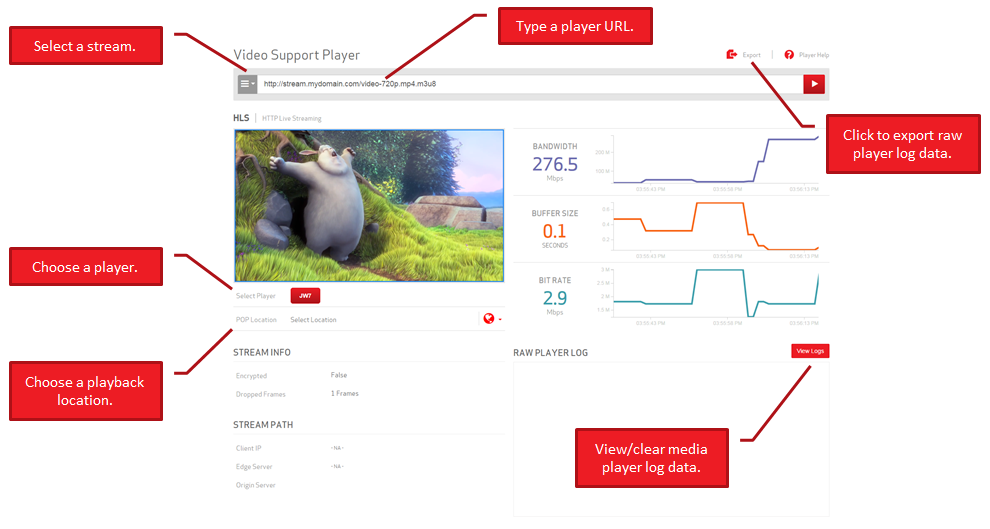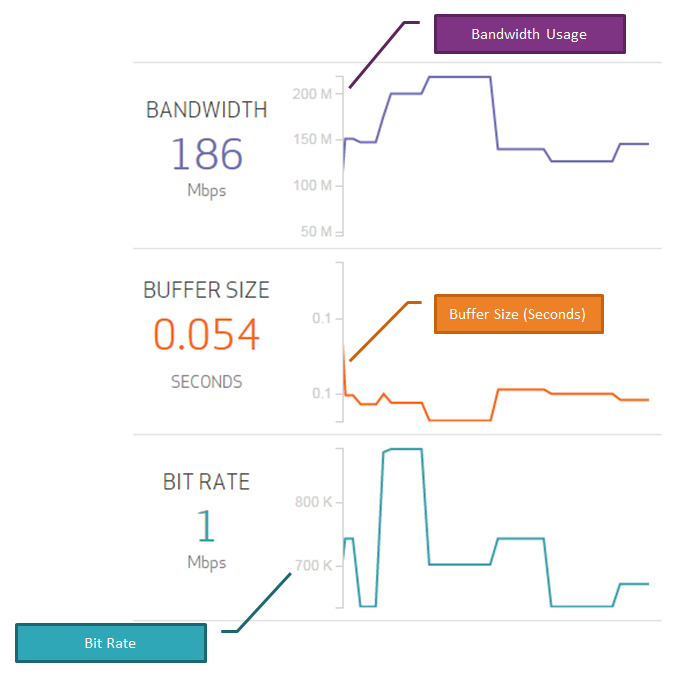The Video Support Player provides the means to playback a stream and then monitor performance statistics. The following illustration highlights key interactive aspects of this tool.

Stream Selection
The stream selection bar at the top of the page allows the playback of:
- Live streams
- On-demand content
- Sample media
- Recently played media
If the desired on-demand content is not listed, simply type the desired player URL into the stream bar.
Switching to a different stream will reset all graphs and the raw player log data.
Stream Playback Options
Upon selecting a stream, it will be played back directly below the stream bar. The following playback options are provided directly below the video:
| Option | Description |
|---|---|
|
Select Player |
By default, streams are played back using a preset media player that varies according to the selected streaming technology. If the Video Support Player allows the selected media to be played back by multiple media players, then those additional media players will be available for selection in this option. Click on a media player to switch playback to it. |
|
POP Location |
By default, a stream will be played back from the closest POP. However, an option is provided to choose the POP from which the stream will be played back. This option establishes the means through which location-specific issues may be replicated and diagnosed. POPs are categorized by region. More than one POP may be located in the same city. In order to distinguish between various POPs within a city, a POP code is appended to the city name (e.g., Los Angeles (OXR)). |
Switching media players or POP location will reset all graphs and the raw player log data.
Playback Information
The Video Support Player provides the following information on stream playback:
| Item | Description |
|---|---|
|
Stream Type |
Indicates the streaming technology used to play back the media. Valid values are:
This information is also displayed directly above the player. Additionally, a LIVE tag will indicate whether a live event or on-demand content is being played back. |
|
Codec |
Indicates the codec (e.g., h.264) used to encode the media being played back. |
|
Frames/Seconds |
Indicates the number of frames per second being played back. |
|
Dropped Frames |
Indicates the number of frames per second that were dropped by the encoder. Check the following on the computer hosting the encoder:
Try:
|
|
Hostname |
Indicates the hostname from which the stream is being played back. |
|
Server IP |
Indicates the IP address of the edge server streaming content to this session. This field may be used by Technical Customer Support to troubleshoot issues that are specific to an individual edge server. |
|
Playback VIP |
Indicates the virtual IP address of the edge server streaming content to this session. This field may be used by Technical Customer Support to troubleshoot issues that are specific to an individual edge server. |
|
Client IP |
Indicates the IP address of the client requesting the stream. |
|
Geo Location |
Indicates the location of the client requesting the stream. Format (United States): City, State Format (International): City, Province |
|
Point of Presence (POP) |
Indicates the location of the POP delivering the stream. Format (United States): City, State Format (International): City, Province |
Real-Time Playback Statistics
The following real-time data is graphed when playing back a stream:
| Data | Description |
|---|---|
|
Bandwidth |
Tracks the stream's bandwidth usage (e.g., Mbps or Kbps) over the last minute. |
|
Buffer Size |
Tracks size of the available buffer, in seconds, over the last minute Low buffer levels are indicative of conditions that may cause buffering or stuttering issues. |
|
Bit Rate |
Tracks the stream's bit rate (e.g., Mbps or Kbps) over the last minute. |
The current value for a metric is reported directly to the left of its graph. The unit type in which that metric is reported is displayed directly below that value.
Low levels or large fluctuations in any of the above metrics may be indicative of:
- Client CPU/bandwidth/network issues
- Encoder CPU/bandwidth/network issues
Graphs for all three metrics are shown below. The callouts describe the x and y-axes.

More Information
Edgecast CDN